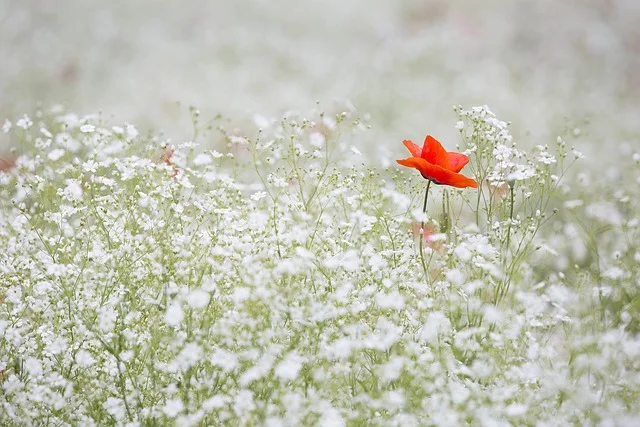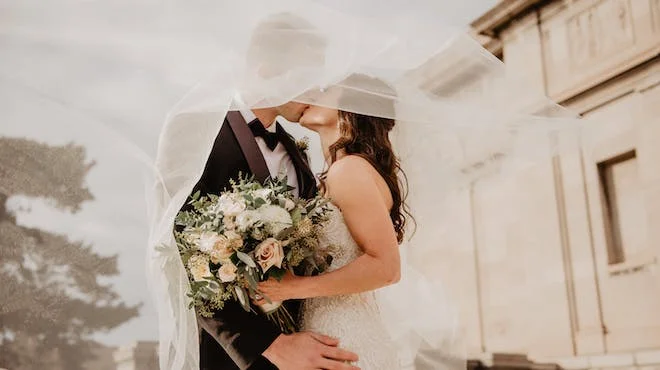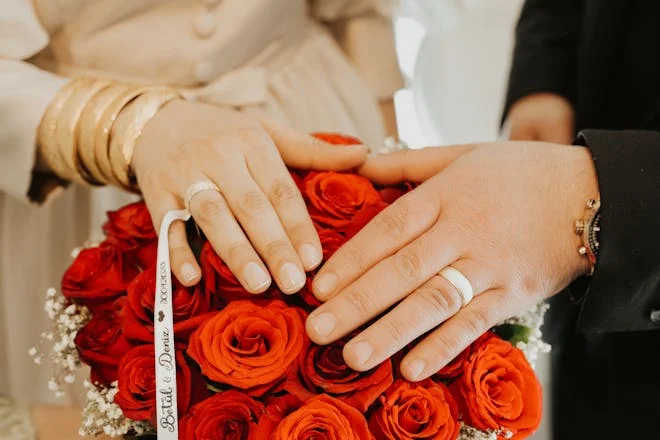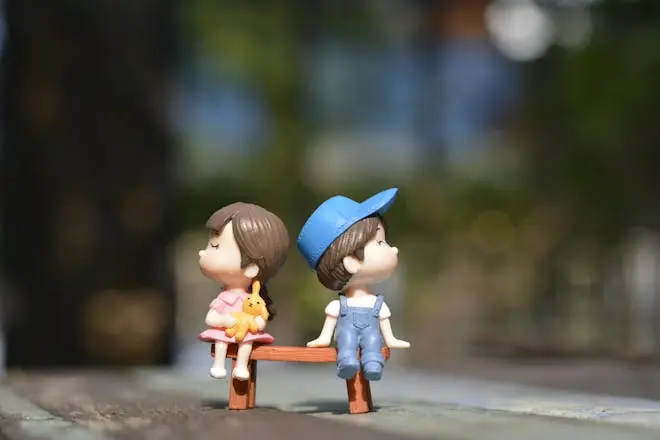
Eulalie is a poem by Edgar Allan Poe that celebrates the transformative power of love. Unlike many of his other works, which often depict the death and loss of a beautiful woman, this poem portrays a happy and harmonious marriage that brings joy and peace to the narrator.
The poem uses vivid imagery, musical language, and symbolic references to contrast the narrator’s dark and lonely past with his bright and blissful present. In this analysis, we will examine how Poe uses these literary devices to convey his theme of love as a source of light and life.
Eulalie by Edgar Allan Poe I dwelt alone In a world of moan, And my soul was a stagnant tide Till the fair and gentle Eulalie became my blushing bride — Till the yellow-haired young Eulalie became my smiling bride. And ah! less bright The stars of the night Than the eyes of the radiant girl, And never a flake Their lustre can make Of the vapor and gold and pearl Can vie with the sweet young Eulalie’s most unregarded curl — Can compare with the bright-eyed Eulalie’s most humble and careless curl. Now Doubt — now Pain Come never again, For her soul gives me sigh for sigh, And all day long Shines bright and strong Astarté within the sky, And ever to it dear Eulalie upturns her matron eye — And ever to it young Eulalie upturns her violet eye.
What is the poem about?
“Eulalie” is a poem by Edgar Allan Poe that was first published in 1845. Here, the speaker expresses his joy and happiness after marrying the beautiful Eulalie. The poem is a contrast to Poe’s usual dark and gloomy themes, as it celebrates love and light. The speaker describes how his life was miserable and lonely before he met Eulalie and how she transformed his soul and brightened his world.
He compares her eyes to the stars, her hair to the moon, and her soul to the goddess Astarte. He declares that he has no more doubt or pain and that he is content with his wife. The poem is a tribute to Poe’s cousin and wife, Virginia, who died of tuberculosis at the age of 26. She died after two years of publishing this masterpiece.
Who was the poet?
Edgar Allan Poe was an American writer, poet, critic, and editor who lived from 1809 to 1849. He is widely regarded as one of the most influential and original authors of the American Romanticism and Gothic fiction movements. He is also considered the inventor of the detective fiction genre and a pioneer of science fiction.
Poe had a tragic and turbulent life that was marked by loss, addiction, and poverty. Young and orphaned, his foster parents never formally adopted him. Poe had a strained relationship with his foster father, who disapproved of his literary ambitions. He quit college and military school, and it was hard for him to make a living as a writer and editor. His cousin Virginia Clemm, who was 13, married him. After 11 years of marriage, she died of tuberculosis. He suffered from depression, alcoholism, and drug abuse and died under mysterious circumstances at the age of 40.
Poe’s life was characterized by a fascination with the dark and mysterious. His work also explored the depths of the human psyche and emotions. He wrote about themes such as death, madness, love, revenge, guilt, and fear. Poe employed various literary devices, such as irony, symbolism, allegory, and imagery, to explore these themes in his works.
He created some of the most memorable and iconic characters and stories in American literature. Some of them are the raven, the black cat, the tell-tale heart, and the murders in the Rue Morgue. He had an impact on many other authors and genres, including Arthur Conan Doyle, H.P. Lovecraft, Jules Verne, and Stephen King.
What is the context of the poem?
Poe wrote “Eulalie” in 1845, during a period of relative success and stability in his life. He had moved to New York City in 1844 and published his most famous poem, “The Raven”, in January 1845. He became a popular and celebrated figure in the literary scene and received praise and recognition for his work. Furthermore, he also edited and contributed to several magazines, such as the Broadway Journal and the American Review.
“Eulalie” was first published in the July 1845 issue of the American Review. It was reprinted shortly thereafter in the August 9, 1845, issue of the Broadway Journal. The poem is a contrast to Poe’s usual dark and gloomy themes, as it celebrates love and light. The poem is a tribute to Poe’s cousin and wife, Virginia, who was his source of happiness and inspiration. Poe and Virginia had married in 1836, when she was only 13 years old. They shared a deep and passionate bond, and Poe was devoted to her. However, Virginia suffered from tuberculosis, a fatal disease at the time, and her health deteriorated gradually. Poe’s agonizing fear of losing her influenced both his poetry and prose.
“Eulalie” is one of the few poems by Poe that expresses joy and optimism rather than sorrow and despair. It is also one of the few poems by Poe with a happy ending rather than a tragic one. The poem reflects Poe’s admiration for his wife and his gratitude for her love. The poem also shows Poe’s affinity for the American Romanticism movement, emphasizing emotion, imagination, and nature. Poe used vivid imagery, symbolism, and musical language to create a lyrical and harmonious poem. He also used classical references, such as Astarte, the Phoenician goddess of love and fertility, to enhance the poem’s meaning and beauty.
What is the theme and tone of the poem?
The theme of the poem is that romantic, all-consuming love brings great joy, uniting man and woman, soul to soul. Where once the man walked only in darkness, he now walks only in light—the brilliant light of Eulalie’s shining beauty. The poem also suggests that love can overcome sorrow and despair and heal the wounds of the past. The speaker has no more doubt or pain, and his soul is at peace with his wife.
The tone of the poem is romantic, joyful, and grateful. The speaker expresses his happiness and appreciation for his wife and praises her physical and spiritual qualities. He uses vivid and colorful imagery, such as the stars, the moon, the vapor, and the goddess Astarte, to describe her eyes, hair, soul, and smile. He also uses musical and rhythmic language, such as rhyme, alliteration, and repetition, to create a lyrical and harmonious poem. The poem has a cheerful and optimistic mood, contrasting with Poe’s usual dark and gloomy style.
What is the form or structure of the poem?
“Eulalie” is a short poem that consists of three stanzas. The first stanza has five lines, while the second and third stanzas have eight lines each. The poem follows an irregular rhyme scheme, with some lines rhyming and some not.
The rhyme scheme of the first stanza is ABABB. The rhyme scheme of the second and third stanzas is ABABCDED. The poem also utilizes internal rhyme, where words within the same line rhyme with each other, like “moan” and “alone” or “bright” and “night”.
The poem does not have a consistent meter, which means that the number and type of syllables in each line vary. However, the poem primarily uses iambic and anapestic feet, which are two-syllable units with an unstressed syllable and a stressed syllable or two unstressed syllables and a stressed syllable, respectively. For example, the first line of the poem, “I dwelt alone”, is iambic, while the second line, “In a world of moan”, is anapestic. The poem also uses some trochaic feet, which are two-syllable units that have a stressed syllable followed by an unstressed syllable, such as “Eulalie” or “Astarte”.
Poetic Devices Used in “Eulalie” by Edgar Allan Poe

Understatement
One of the literary devices that Poe uses in his poem “Eulalie” is understatement. This is when the writer deliberately represents something as much less significant or serious than it really is.
For example, in the first line of the poem, the speaker says “I dwelt alone”. This is an understatement because it minimizes the significance of their solitude. Additionally, the poet refrains from going into the depths of their loneliness or isolation.
Metaphor
Another literary device that Poe uses is metaphor. This is a figure of speech in which a word or phrase is applied to an object or action to which it is not literally applicable.
For example, in the second line of the poem, the speaker says, “And my soul was a stagnant tide”. This is a metaphor because the speaker compares their soul to a stagnant tide. This implies a lack of movement or vitality.
Alliteration
Poe also uses alliteration, which is the occurrence of the same letter or sound at the beginning of adjacent or closely connected words.
For example, in the third line of the poem, the speaker says, “In a world of moan”. This is an example of alliteration because the repetition of the “w” and “m” sounds emphasizes the speaker’s negative emotions and creates a sense of gloom.
Simile
Another figure of speech that Poe uses is simile, which is a comparison of one thing with another thing of a different kind, using “like” or “as”. For example, in the seventh line of the poem, the speaker says “For her soul gives me sigh for sigh”. This is a simile because the speaker compares the connection between their soul and their wife’s soul to sighs. This signifies a deep emotional resonance.
Imagery
Poe also uses imagery, which is the use of figurative language to represent objects, actions, and ideas in a way that appeals to the physical senses. For example, in the eighth and ninth lines of the poem, the speaker says “And never a flake / Their lustre can make”. This is an example of imagery because the poet uses the images of vapor, gold, and pearl to emphasize their inability to match the radiance of the girl’s eyes.
Repetition
Another literary device that Poe uses is repetition, which is the recurrence of words, phrases, or lines in a poem, usually for emphasis or effect. For example, in the tenth and eleventh lines of the poem, the speaker says, “Till the fair and gentle Eulalie became my blushing bride- / Till the yellow-haired young Eulalie became my smiling bride”. This is an example of repetition because the poet repeats the words “till” and “my bride”. Intension of this is to emphasize the transformative impact of Eulalie’s presence in the speaker’s life.
Color Imagery
Another type of imagery that Poe uses is color imagery. Color imagery is a description using colors to evoke certain emotions or associations. For example, in the twelfth line of the poem, the speaker says, “Shines, bright and strong”. This is an example of color imagery because the poet uses the word “bright” to evoke a sense of light and positivity, enhancing the depiction of the speaker’s wife as radiant.
Adjectives
Poe also uses adjectives, which are words that describe or modify nouns, adding detail or information. For example, in the tenth line of the poem, the speaker says, “The fair and gentle Eulalie”. This is an example of an adjective because the poet uses the words “fair” and “gentle”. The purpose of this is to enhance the portrayal of Eulalie as kind and beautiful.
Antithesis
Another rhetorical device that Poe uses is antithesis, which is when two opposite ideas are put together in a sentence to achieve a contrasting effect. For example, in the fifth line of the poem, the speaker says, “Now Doubt- now Pain”. This is an example of antithesis because the poet juxtaposes the words “doubt” and “pain” to highlight the absence of negative emotions in the speaker’s current state.
Caesura
Poe also uses caesura, which is a pause or break in a line of verse, often indicated by punctuation, to create rhythm or emphasis. For example, in the fifth line of the poem, the speaker says, “Now Doubt- now Pain”. This is an example of caesura because the poet uses a dash to create a pause in the line, drawing attention to the contrasting emotions mentioned.
Hyperbole
Another literary device that Poe uses is hyperbole, which is exaggerated statements or claims not meant to be taken literally. For example, in the sixth line of the poem, the speaker says, “Come never again”. This is an example of hyperbole because the speaker exaggerates by expressing certainty that doubt and pain will never return.
Allusion
Poe also uses allusion, which is a brief and indirect reference to a person, place, thing, or idea of historical, cultural, literary, or political significance. For example, in the thirteenth line of the poem, the speaker says, “Astarte within the sky”. This is an example of allusion because the poet refers to Astarte, a goddess of love and fertility in ancient Near Eastern mythology, to allude to the celestial beauty and divinity of the speaker’s wife.
Personification
The last literary device that Poe uses is personification, which is the attribution of human characteristics to something non-human. For example, in the fourteenth line of the poem, the speaker says “While ever to her dear Eulalie upturns her matron eye”. This is an example of personification because the poet gives Eulalie’s eye human qualities, such as being matronly and affectionate.
Line-by-line Analysis
To analyze the poem, we will look at each line and identify the techniques and figures of speech used by the poet. Additionally, we will examine how they enhance the poem’s message and mood. We will also provide some examples and details for each device.
Line-by-line Analysis of the First Stanza of “Eulalie” by Edgar Allan Poe
Line 1: “I dwelt alone”
The first line uses understatement to describe the speaker’s previous state of loneliness and isolation. The speaker does not elaborate on how he felt or why he was alone, but simply states it as a fact. This creates a contrast with the rest of the poem, where he expresses his joy and happiness after meeting Eulalie. The word “dwelt” also implies that he lived in the past and that his situation has changed since then.
Line 2: “In a world of moan,”
The second line uses metaphor and alliteration to describe the speaker’s previous environment and mood. The speaker compares his world to a moan, which is a sound of pain or sorrow. This suggests that he was depressed and suffering, and that he had no joy or hope. The alliteration of the “w” and “m” sounds creates a harsh and gloomy tone and emphasizes the speaker’s negative feelings. The word “world” also suggests that he felt alienated and isolated from others and that he had no connection or belonging.
Line 3: “And my soul was a stagnant tide,”
The third line uses similes and imagery to describe the speaker’s previous condition and state of mind. The speaker compares his soul to a stagnant tide, which is a body of water that does not move or flow. This implies that he was stuck in a rut and that he had no passion or motivation. The image of a stagnant tide also evokes a sense of decay and foulness. This suggests that the speaker was unhappy and unhealthy. The word “soul” also indicates that he felt spiritually and emotionally empty and that he had no purpose or meaning.
Lines 4 and 5: “Till the fair and gentle Eulalie became my blushing bride-“,”Till the yellow-haired young Eulalie became my smiling bride.”
The fourth and fifth lines use repetition, rhyme, color, and adjectives to describe the speaker’s wife and the change she brought to his life. The speaker repeats the name of his wife, Eulalie, and the phrase “my bride”, to show his love and devotion for her. He also rhymes these words with the previous lines to create a musical and harmonious effect.
The poet uses color and adjectives to portray Eulalie’s physical and emotional attributes, such as her hair, skin, age, and expression. He contrasts her with his previous world of moaning and shows how she brightened and transformed his life. The words “blushing” and “smiling” also imply that Eulalie is happy and in love with him and that she shares his feelings. The word “young” also suggests that Eulalie is full of life and vitality and that she brings him joy and energy.
Line-by-line Analysis of the Second Stanza of “Eulalie” by Edgar Allan Poe
Line 1: “And ah! less bright”
The first line of the second stanza begins with an interjection expressing the speaker’s admiration or awe, setting a tone of wonder or reverence. The speaker compares the brightness of the stars to that of a radiant girl, suggesting that the girl’s beauty surpasses that of the stars. This comparison highlights the speaker’s intense admiration for the girl and elevates her to a celestial level of beauty.
Line 2: “The stars of the night”
The second line elaborates on the comparison introduced in the previous line, emphasizing the brightness of the stars in the night sky. The stars serve as a symbol of celestial beauty and magnificence, contrasting with the terrestrial beauty of the radiant girl. This comparison reinforces the idea that the girl’s beauty is exceptional and transcendent.
Line 3: “Than the eyes of the radiant girl,”
The third line continues the comparison between the brightness of the stars and the girl’s eyes. The speaker emphasizes the girl’s eyes as the focal point of her beauty, suggesting that they possess a captivating and luminous quality that outshines the stars. This line further enhances the image of the girl’s radiant beauty and its impact on the speaker.
Line 4: “And never a flake”
The fourth line introduces a new element into the comparison, referring to “flake” as a metaphorical representation of beauty or purity. The speaker suggests that no flake, whether of vapor, gold, or pearl, can rival the luminosity or splendor of the girl’s eyes. This assertion reinforces the extraordinary nature of the girl’s beauty and the profound effect it has on the speaker.
Line 5: “Their lustre can make”
The fifth line elaborates on the inability of vapor, gold, or pearl to match the radiance of the girl’s eyes. The word “lustre” emphasizes the shining quality of these materials but underscores their inadequacy compared to the girl’s beauty. This line strengthens the speaker’s assertion of the girl’s unparalleled allure and highlights the intensity of his admiration for her.
Line 6: “Of the vapor and gold and pearl”
The sixth line lists specific substances—vapor, gold, and pearl—that are traditionally associated with beauty and luxury. By juxtaposing these materials, the speaker underscores the diversity of elements unable to match the girl’s radiance. This enumeration further accentuates the exceptional nature of the girl’s beauty and the impossibility of replicating it with earthly materials.
Line 7: “Can vie with the sweet young Eulalie’s most unregarded curl —”
The seventh line concludes the comparison by emphasizing the insignificance of even the girl’s most overlooked feature—her curl—in comparison to other objects of beauty. The word “vie” suggests competition or rivalry, emphasizing the girl’s supremacy in beauty. This line reinforces the idea that the girl’s beauty transcends earthly standards and is incomparable in its splendor and allure.
Line-by-line Analysis of the Third Stanza of “Eulalie” by Edgar Allan Poe

Line 1: “Now Doubt- now Pain”
The first line uses antithesis and caesura to describe the speaker’s absence of negative emotions. The speaker contrasts doubt and pain, which are opposite or contradictory feelings. He also uses a dash to create a pause or break in the line, which adds drama and emphasis. The speaker shows that he has no more doubt or pain and that he is confident and happy.
Line 2: “Come never again,”
The second line uses hyperbole and repetition to express the speaker’s hope and certainty. The speaker exaggerates by saying that doubt and pain will never come again, which means that he is sure that they will not return. He also repeats the word “come”, which reinforces his hope and certainty and creates a rhythmic and musical effect.
Line 3: “For her soul gives me sigh for sigh,”
The third line uses simile and alliteration to describe the speaker’s connection and harmony with his wife. The speaker compares his soul and his wife’s soul to sighs, which are sounds of relief or contentment. He also uses the “s” sound to create a soft and soothing tone and to emphasize their similarity and compatibility. The speaker shows that he and his wife are in sync and in tune with each other, and that they share their feelings and thoughts.
Line 4: “And all day long”
The fourth line uses exaggeration and color to describe the speaker’s duration and mood. The speaker exaggerates by saying that he spends all day long with his wife, which means that he enjoys every moment with her and that he is always happy and cheerful. He also uses the word “long” to imply a light or bright color, such as yellow or gold, which symbolizes joy and warmth. The speaker shows that he is optimistic and cheerful and that he finds beauty and joy in everything.
Line 5: “Shines, bright and strong,”
The fifth line uses personification and adjectives to describe the speaker’s wife and her influence. The speaker personifies his wife as a shining star, which means that she is radiant and beautiful and that she illuminates his life. He also uses adjectives to portray her physical and emotional attributes, such as her brightness and strength, which imply that she is lively and powerful and that she supports and inspires him.
Line 6: “Astarte within the sky,”
The sixth line uses allusion and imagery to describe the speaker’s wife and her comparison. The speaker alludes to Astarte, a classical deity who was associated with the moon and the stars and who was worshipped as a symbol of love and fertility. He compares his wife to Astarte, which means that she is divine and celestial and that she is the source of his love and happiness. He also creates an image of his wife shining in the sky, which means that she is high and noble and that she is visible and admired by everyone.
Lines 7 and 8: “While ever to her dear Eulalie upturns her matron eye”, “While ever to her young Eulalie upturns her violet eye.”
The seventh and eighth lines use repetition, rhyme, contrast, and color to describe the speaker’s wife and her gaze. The speaker repeats the name of his wife, Eulalie, and the word “eye”, to show his love and devotion for her. He also rhymes these words with the previous lines to create a musical and harmonious effect. Furthermore, he contrasts his wife’s age and status, which means that she is both his old and new love, and that she is both his wife and his lover. He also uses the word “violet” to imply a dark or cool colour, such as purple or blue, which symbolizes mystery and depth, suggesting that his wife has a complex and intriguing personality.
What is the summary of “Eulalie” by Edgar Allan Poe?
“Eulalie” is a poem by Edgar Allan Poe that celebrates the power and beauty of love. The speaker tells how his life was dark and miserable until he met and married the lovely Eulalie, who brightened his world and healed his soul. He praises her physical and spiritual qualities and compares her to the stars, the moon, and the goddess Astarte.
He declares that he has no more doubt or pain and that he is content with his wife. The poem is a contrast to Poe’s usual themes of death, madness, and horror and reflects his admiration for his cousin and wife Virginia, who died of tuberculosis shortly after the poem was published.
The poem uses vivid imagery, symbolism, alliteration, rhyme, and other poetic devices to create a lyrical and harmonious poem that expresses joy and gratitude. This is a rare example of Poe’s optimistic and romantic side and shows how love can overcome sorrow and despair.
If you want to learn more about Edgar Allen Poe’s work, please read our review of “A Dream Within a Dream.”
RELATED POSTS
View all



